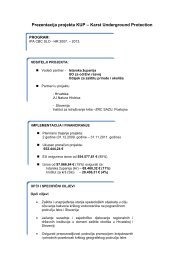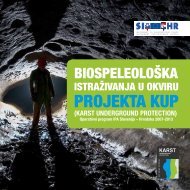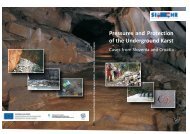prvi hrvatski speleološki kongres - KARST underground protection
prvi hrvatski speleološki kongres - KARST underground protection
prvi hrvatski speleološki kongres - KARST underground protection
You also want an ePaper? Increase the reach of your titles
YUMPU automatically turns print PDFs into web optimized ePapers that Google loves.
Literatura:<br />
DANZ, DP. (2007): Accidental hypothermia. In:Auerbach, PS. (Ed.),Wilderness<br />
Medicine. Philadelphia: Mosby: 125-160.<br />
DANZL, DF., POZOS, RS. (1994): Accidental hypothermia. N. Engl. J.<br />
Med.,331(26):1756-1760.<br />
WEINBERG, AD.(1993): Hypothermia. Ann. Emerg. Med.,22(2):370-377.<br />
Archaeology and palaeo-speleology at the cave Zala<br />
Arheologija i paleospeleologija u spilji Zala<br />
Giovanni Boschian 1 , Rajna Šošić 2 , Katarina Gerometta 3 , & Ivor Karavanić 4<br />
1<br />
Dipartimento di Scienze Archeologiche, Università di Pisa, 53 via S. Maria I-56100 Pisa, Italy,<br />
boschian@arch.unipi.it<br />
2<br />
Odsjek za arheologiju, Filozofski fakultet, Ivana Luĉića 3 HR-10000 Zagreb, rsosic@ffzg.hr<br />
3<br />
Dalmatinska 26, HR-52450 Vrsar, kgerometta@mail.com<br />
4<br />
Odsjek za arheologiju, Filozofski fakultet, Ivana Luĉića 3 HR-10000 Zagreb, ikaravan@ffzg.hr<br />
Key words: Zala cave, geoarchaeology, sedimentology, palaeoclimate<br />
Ključne riječi: spilja Zala, geioarheologija, sedimentologija, paleo klima<br />
The cave Zala is situated North-east of Ogulin (Gorski kotar, Croatia), in a<br />
karstic area developed on Lower Cretaceous limestones. It belongs to a complex<br />
<strong>underground</strong> system, whose most important entrances are the Đulin ponor -<br />
Medvedica cave system and the Gojak spring cave; at present, the cave is acting as a<br />
secondary spring connected to the Bistrica stream, which flows few hundred metres<br />
far from the cave. Archaeological excavations have been carried out by the<br />
Department of Archaeology, Faculty of humanities and social Sciences, University of<br />
Zagreb (prof. Ivor Karavanić) in the outer part of the cave, a small dry chamber<br />
connected to the inner system by a short passage. The excavations have put into light<br />
traces of human frequentation that span from the Late Upper Palaeolithic to the<br />
Middle Ages indicating a long and recurring -though apparently discontinuous- use of<br />
the cave for shelter. It appears that archaeological data and composition and quantity<br />
of finds indicate many short-term occupation episodes during various archaeological<br />
periods. Beside abovementioned periods, traces of human activity from periods of late<br />
Antiquity, late Bronze Age and Mesolithic were also documented. In Bronze age and<br />
Mesolithic layer traces of several hearths were found. Other levels contained only<br />
finds of fragmented pottery or lithics and animal bones.<br />
The geoarchaeological aspects of the clastic infilling of the cave are at present<br />
under examination, mostly through sedimentological and soil micromorphological<br />
55










